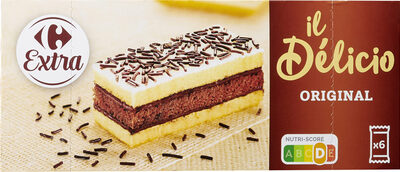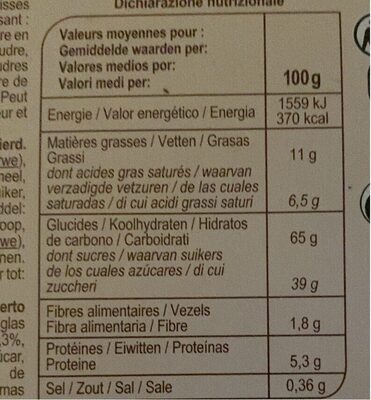il Délicio Original - Carrefour - 182 g
Aquesta pàgina del producte no està completa. Podeu ajudar a completar-la editant-la i afegint-hi més dades a partir de les fotos ja disponibles, o fent-ne més amb l'aplicació de androide o iPhone / iPad. Gràcies!
×
Algunes de les dades d’aquest producte les ha proporcionat directament el fabricant Carrefour.
Codi de barres: 3560071260156 (EAN / EAN-13)
Nom comú: Génoises avec fourrage (18,3%) goût chocolat, nappées et décorées.
Quantitat: 182 g
Marques: Carrefour
Categories: Snacks, Postres, Aperitius dolços, Galetes i pastissos, Pastís, en:Filled sponge cake slices
Etiquetes, certificacions, premis:
Punt verd, Comptador Nutricional, Grau D NutriScore
Productor: Fabriqué par Bouvard Italia S.p.A, Via N. Nigris, 26 - 33034 Fagagna (UD) – Italie.
Botigues: Carrefour, carrefour.fr
Països on es va vendre: França, Itàlia, Polònia, Romania, Espanya
Matching with your preferences
Entorn
Empaquetament
Transport
Espècies amenaçades
Altres dades
Condicions de conservació: A conserver à l'abri de la chaleur et de l'humidité. Pour une dégustation optimale, à consommer de préférence avant le / N° de lot : voir sur le côté de l'étui.
Servei al client: Interdis - TSA 91431 - 91343 MASSY Cedex - France
Report a problem
Fonts de dades
Producte afegit per kiliweb
Última modificació de la pàgina del producte per org-carrefour.
La pàgina del producte, també editada per charlesnepote, driveoff, ecoscore-impact-estimator, moon-rabbit, openfoodfacts-contributors, quechoisir, roboto-app, spotter, stive24, teolemon, vaporous, yuka.Xa9pLNDaDsp9LPHZ_7wu2TfkNP79OdldMVAhow, yuka.sY2b0xO6T85zoF3NwEKvlhZ1DfbF-irFDU3mvmyM_9DSDJ7VRf1Y7broCKs, yuka.sY2b0xO6T85zoF3NwEKvlkBkWYD1nBDOMgHWmFfWwvWvKZXpUNxq5bbTb6o, yuka.sY2b0xO6T85zoF3NwEKvll5fU4DVjC3NNgThl1XW14i-coe3Q4pU-Jjab6s, yuka.sY2b0xO6T85zoF3NwEKvllZ4Q93DoRv2ECXUt1-v9o-TKJfpSshY7oPCGao, yuka.sY2b0xO6T85zoF3NwEKvlmZJCtOAvjXFFDrup2uZ7PCoErGzWfhW-dfWE6s, yuka.sY2b0xO6T85zoF3NwEKvlnUdfPrZqx-aN0LvpnSxn4uiErrIQ8lg-9TBaas.










